

| Home | Log In | Register | Our Services | My Account | Contact | Help |
You are NOT currently logged in
dai oldenrich - 01 Sep 2006 13:32
click your browser refresh button to update charts
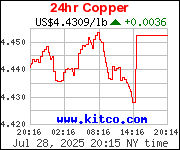
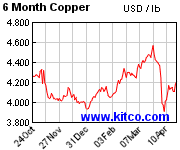
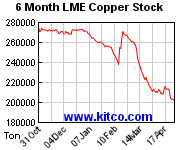
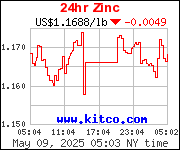
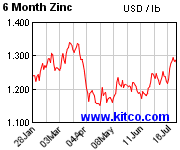
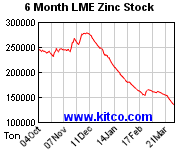
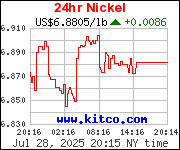
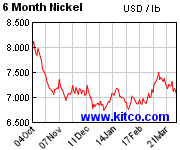
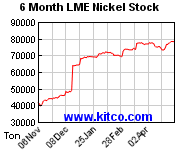
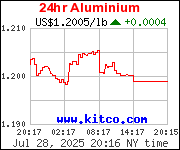
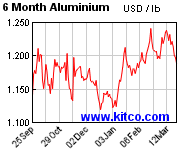
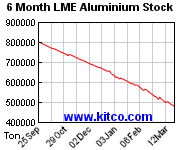
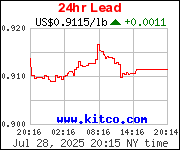
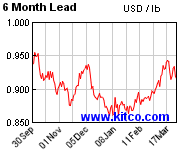
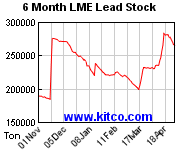
Also see: gold charts here silver charts here platinum charts here
dai oldenrich - 26 Sep 2006 07:04 - 52 of 181
Platts Metals Alert - 09/25/06
Copper was stuck in a tight range during Monday's premarket session on the London Metal Exchange, while market players were continuing to closely watch out for further action on fund favorites--aluminium and zinc. Three-months copper was bid down $120 at $7,430/mt at 0901 GMT from Friday's kerb close of $7,550/mt. The red metal would need to hold first line support at $7,250/mt or risk falling further, warned an LME trader. On the upside, copper would need to close above $7,600/mt to cement a new drive higher, he added. Copper's current range of $400 was deemed to be rather small, he said. "It [copper] seems to be fairly indifferent to the usual influences like gold, oil etc....and the short term guys don't have a position at the moment," he suggested, adding that even the funds weren't currently active in the red metal either. "The long term guys didn't get strong enough signals on copper [to be able to make any new positions]," he added.
In contrast, aluminium and zinc have been very well traded of late with large volumes seen done on the exchange, he said. Aluminium has a good "base of business" and very active fund buying, he added. The metal was trading an extremely wide range sandwiched between support at $2,400/mt and overhead resistance at $2,680/mt. Although in the short term the range was seen at $2,480/mt to $2,550/mt, suggested the trader. With fundamentals for aluminium in equilibrium, the metal seemed to be drifting. "It needs an outside influence to move it...some money flying around for example...at the moment it's anyone's guess which way it will go," he added. Total aluminium stocks were up a net 2,300 mt at 695,350 mt, according to LME data Monday. Zinc prices were markedly lower at $3,310/mt, off over $100 from its previous kerb close. The metal would need to hold on to support at $3,320/mt, he said.
"Zinc is more prone to bigger downside corrections...the way it is traded--it is more prone to setbacks," the trader explained. Meanwhile, in the rest of the base metals complex nickel was bid $250 lower at $27,350/mt, down from Friday's close of $27,600/mt. Stock-watching remained the theme of the nickel market, he said, adding: "If the nickel stocks stabilize or creep up then the price will come off." The trader suggested that if the short stock situation eased sufficiently and nickel didn't have the fundamentals to prop it up, then three-months nickel prices could easily see as much as $5,000/mt sliced off. "Many in the market have been using the LME stocks as a visible indicator on nickel," he added. LME-registered nickel stocks were barely moved Monday, showing a 6 mt rise to a total 6,036 mt with just 3,288 mt available on warrant. Tin was off $25 at $8,900/mt, while lead was off $12 at $1,350/mt. Aluminium alloy was bid at $2,220/mt with the NASAAC at $2,190/mt.
dai oldenrich - 26 Sep 2006 07:04 - 53 of 181
Mumbai, Sep 25, 2006 (Asia Pulse Data Source via COMTEX)
Led by nickel, metal prices declined on the non-ferrous metal market here today on lack of industrial demand.
Nickel dropped by Rs 20 per kilo to Rs 1720 from Rs 1740 previously, followed by copper utensils scrap by Rs 3 per kilo to Rs 322, copper cable scrap to Rs 380 per kilo, copper scrap heavy to Rs 371 per kilo, copper Armeture to Rs 355 per kilo, copper wire bar to Rs 408 per kilo, copper sheets cutting to Rs 343 per kilo, brass utnensils scrap to Rs 226 per kilo, brass sheets cutting to Rs 263 per kilo, aluminium utensils scrap to Rs 103.50 per kilo, tin to Rs 515 per kilo and zinc to Rs 189 per kilo.
dai oldenrich - 26 Sep 2006 07:04 - 54 of 181
Daily Telegraph - Market report - By Simon Goodley - (Filed: 26/09/2006)
London's reliance on Big Oil and metals caused a gloomy session for traders, as the price of a barrel of crude dropped below $60, provoking investors to re-evaluate their positions.
BP, one of the FTSE's biggest losers on the day, dropped 10 to 563p, despite news that the company had moved to restore output at Prudhoe Bay earlier than expected. Rival Shell lost 19p to 17.40. Meanwhile Tullow Oil dropped 7 to 350p after the company said it had agreed to acquire Australian oil and gas company Hardman Resources, up 25 to 78p, in a deal worth $1.11bn (584m).
Mining stocks were also caught up in the fall as base metals slipped on growing nervousness about falling demand. Vedanta, which has been suffering problems at one of its projects in India, was the main casualty, down 81p to 11.12. Elsewhere in the sector Xstrata was off 23p to 20.36, BHP Billiton down 34 to 853p, Anglo American 74p cheaper at 20.60 and Rio Tinto down 55p to 23.52.
Oil and mining sectors account for around 40pc of the FTSE, meaning that the sell-off was particularly keenly felt in London, pushing the benchmark FTSE 100 down 24 points to 5798. The mid-cap FTSE 250 lost 28.2 to close on 9755.8, while in New York the Dow Jones was trading off about 15 points at 11492 as City traders went home.
"The FTSE has given up its support at 5820 and has remained the weakest index in Europe," said Angus Campbell, a market strategist at spread betting group Finspreads. "With so much of the rally in the past 18 months coming from high expectations of increased earnings for oil and mining companies, the reversal of crude and metal prices has really caused investors in these stocks to reconsider their positions. Our clients are becoming defensive, being largely short of the FTSE with the expectation that equity prices will fall further in the weeks ahead."
Traders added that the market has broken its two week downside - a worry considering we are approaching October, traditionally a weak month.
dai oldenrich - 26 Sep 2006 07:08 - 55 of 181
Dow Jones Newswires - Tuesday, September 26, 2006
UBS Lowers Iron Ore Forecast
UBS cuts its iron ore forecasts and reduces earnings for BHP Billiton and Rio Tinto as result. Now expects 5% drop in iron ore prices in 2007, where previously forecasting 10% rise. Lowers Rio earnings forecast for CY07 by 6% and BHP by 3%. Cites growing iron ore production in China as well as slowing materials consumption.
dai oldenrich - 27 Sep 2006 07:11 - 56 of 181
The Canadian Press via COMTEX - Sep 26, 2006
Bull run for commodity market broken and will remain under pressure, BMO says
A 4 1/2-year bullish trend for commodity markets has been broken and they will remain under serious pressure in the near term, according to a Bank of Montreal economist.
While the long-term trend remains positive, the recent downward move in commodity prices differs from earlier corrections in the market, senior economist Bart Melek suggested Tuesday in a report.
"Earlier corrections showed that a strong underlying trend can overcome minor negative developments in the fundamentals, but the 'trend is your friend' strategy is unlikely to prove successful as 2007 unfolds," Melek wrote in his report.
"Given oil prices are down 22 per cent from their cyclical highs, lumber 26 per cent lower and sharp declines in copper (15 per cent), aluminum (22 per cent), zinc (13 per cent) and nickel (14 per cent) prices, this smells like a break in trend and not just a temporary sell-off."
The Toronto Stock Exchange has post strong gains over the last two years due to strength in metal and energy prices. However, Melek suggested this may not be sustainable with the erosion of commodity prices and the corresponding lower profits in the coming quarters.
"There are increasing worries that the U.S. economy will hit a few speed bumps due to a hard landing for the housing market," Melek wrote.
"If the U.S. economy slumps, the impact on base metals, oil and lumber prices will be fast and relatively furious."
The U.S. National Association of Realtors reported Monday that sales of existing U.S. homes fell for the fifth consecutive month in August as the once-booming housing market slowed further.
Existing home sales slipped by 0.5 per cent to a seasonally adjusted annual rate of 6.30 million units, the association said.
The slowdown in sales was weighing on home prices, with the median price of an existing home sold in August dropping to US$225,000, 1.7 per cent below August 2005. It marked the first year-over-year price decline in more than 11 years.
dai oldenrich - 27 Sep 2006 07:20 - 57 of 181
Sept. 27 (Bloomberg) - By Helen Yuan
Shanghai Copper Falls on Speculation Prices Discouraging Buyers
Copper in Shanghai fell on speculation prices haven't declined enough to attract buying from makers of cables and wire in China, the biggest user of the metal.
Copper for immediate delivery in Changjiang, Shanghai's biggest copper market, fell as much as 0.5 percent to 71,040 yuan ($8,987) today. Prices exceeding 70,000 yuan are discouraging buying from the metal users, said Li Rong, metals analyst at Great Wall Futures Co. in Shanghai.
``Although there isn't much supply on the cash market, prices over 70,000 are keeping some buyers staying sidelines,'' said Li by phone today.
Copper for delivery in November, the most actively traded contract, fell as much as 320 yuan, or 0.5 percent, to 70,000 yuan a ton on the Shanghai Futures Exchange. It traded at 70,180 yuan at the 11:30 a.m. break local time.
Copper demand growth in China may slow to 5.6 percent this year, as record prices prompt makers of cables, wires and air conditioners to switch to cheaper substitutes, said Yang Changhua, senior analyst at Beijing Antaike Information Development Co., today at a conference in Nanjing.
The increase in production of copper products such as tube, wires and rods slowed to less than 7 percent in the seven months to July, Yang said. Air conditioner production growth fell to 1.1 percent in July from 15 percent early this year, he said.
Electric wire and cable production growth slipped to 0.34 percent in June from 10 percent earlier this year, he said. Copper tube, wire and rod producers are the biggest buyers of refined copper. Tube is used in air-conditioners and wires are used in electric equipments.
Copper for delivery in three months on the London Metal Exchange fell $55, or 0.7 percent, to $7,595 a ton.
dai oldenrich - 27 Sep 2006 22:25 - 58 of 181
Bloomberg - Sept. 27
Copper Futures Drop in New York, London, Wiping Earlier Gains
Copper declined in London and New York, erasing earlier gains.
Copper for delivery in three months dropped $80.25, or 1.1 percent, to $7,569.50 a metric ton at 4:16 p.m. on the London Metal Exchange. It earlier gained as much as $120, or 1.6 percent, to $7,770 a ton.
Copper for delivery in December lost 1.6 cents, or 0.5 percent, to $3.45 a pound at 11:16 a.m. on the Comex division of the New York Mercantile Exchange.
dai oldenrich - 28 Sep 2006 07:32 - 59 of 181
Copper Rises in Shanghai as Teck Cominco Workers Set to Strike
By Chia-Peck Wong
Sept. 28 (Bloomberg) -- Copper in Shanghai rose after workers at Teck Cominco Ltd.'s Highland Valley mine said they would strike on Oct. 1 if a new labor agreement isn't reached before then.
A strike will disrupt output at the mine, which produced about 1.2 percent of the 14.9 million tons of copper mined globally in 2005. Copper prices have doubled in the past year amid walkouts at mines in Chile and Mexico.
``A stoppage at Highland Valley would push prices higher,'' Yuan Fang, a metal futures trader at Shanghai Dongya Futures Co., said by phone today.
Copper for delivery in November rose as much as 400 yuan, or 0.6 percent, to 70,740 yuan ($8,956) a metric ton on the Shanghai Futures Exchange. It closed the morning session at 70,580 yuan.
Metal for immediate delivery in Changjiang, Shanghai's biggest copper market, rose as much as 0.6 percent to 71,490 yuan. Chinese users have to pay 17 percent value-added tax, 2 percent import tax, premiums and freight charges for imported copper.
The United Steelworkers, which represents 812 workers at Highland Valley, last night gave Teck Cominco a 72-hour notice of intent to strike, Richard Boyce, president of union local 7619, said in a statement.
``The company refused to put another offer on the table,'' Boyce said yesterday after talks in Kamloops, British Columbia, stalled. ``They have made it obvious they are unwilling or unable to bargain.'' Greg Waller, a spokesman for Vancouver- based Teck Cominco, wasn't immediately available to comment.
Copper for three-month delivery on the London Metal Exchange rose $65, or 0.9 percent, to $7,675 a ton at 11:44 a.m. Shanghai time.
Metal for delivery in December fell 0.5 cents to $3.482 a pound in after-hours trade on the Comex division of the New York Mercantile Exchange at 11:52 a.m. Shanghai time.
dai oldenrich - 28 Sep 2006 21:56 - 60 of 181
NEW YORK (Dow Jones) - 28 September 2006
DJ Comex Copper Review: Faces Selling Pressure To End Lower
Comex copper futures dropped Thursday at the New York Mercantile Exchange as the red metal faced downside pressure while sellers were aggressive in the London copper market.
At settlement, most-active Dec copper was down 590 points at $3.4280 per pound. During the session the contract was unable to push through stiff resistance seen around the $3.50 level. It dropped to a session low of $3.40 - its weakest level since Monday.
Floor traders said copper also faced pressure from a firm dollar and weaker euro.
At 2 p.m. EDT, the Nybot U.S. dollar index is trading at 85.77, up from Wednesday's close of 85.66.
While news of a strike threat at Teck Cominco's (TCK) Highland Valley Copper mine in Canada provided earlier support for copper, it failed to elicit upside momentum.
The union served a 72-hour strike notice and will be in a legal position to take job action at 12:01 a.m. on Oct. 1.
A union official said a mediator has adjourned the talks and requested that both parties return to the table on Sept. 30.
"We will make a last ditch attempt to get a deal and avoid a strike," the union official said.
dai oldenrich - 28 Sep 2006 21:57 - 61 of 181
Bloomberg - Sept. 28
Copper Falls Most Since Sept. 15 as U.S. Economic Growth Slows - By Dale Crofts
Copper prices fell the most in more than a week on signs of a slowing economy in the U.S., the world's second-largest user of the metal.
The U.S. economy grew at an annual rate of 2.6 percent in the second quarter, less than previously estimated, as business spending, consumer demand and homebuilding slowed, the Commerce Department said today. The price of copper, used in wire and pipe, is down 15 percent since reaching a record high on May 11.
``There's some concern about today's low GDP numbers and the slowing housing market in the U.S.,'' said Donald Selkin, director of equity research at Joseph Stevens & Co. in New York. ``The macro factors are restraining any sustained uptrend in prices.''
Copper futures for December delivery were down 5.9 cents, or 1.7 percent, to $3.428 a pound on the Comex division of the New York Mercantile Exchange, the biggest decline for a most- active contract since Sept. 15. Prices are still up 96 percent from a year ago.
Home construction fell at an annual rate of 11.1 percent last quarter, the biggest decline since the second quarter of 1995, the Commerce Department's report showed. That compares with a 9.8 percent drop reported last month and a 0.3 percent decline the first three months of 2006. Housing accounts for 37 percent of U.S. copper demand, Citigroup estimates.
The gain in gross domestic product, the value of all goods and services produced in the country, compares with the Commerce Department's previous estimate of 2.9 percent, and 5.6 percent in the first quarter.
Reports this month suggest the housing slump is deepening as the supply of unsold homes swells. Sales of previously owned homes in the U.S. fell in August to the lowest since early 2004, and prices fell from year-ago levels for the first time since 1995, the National Association of Realtors said this week. Housing starts fell to a three-year low in August.
dai oldenrich - 29 Sep 2006 07:13 - 62 of 181
Bloomberg - 28 September 2006
Codelco to raise copper charge in Europe, people say
Codelco, the world's largest copper producer, plans to raise charges paid by metal buyers in Europe to a record, boosting costs for producers of wires and pipes, according to two people with knowledge of the industry.
European copper consumers will pay between $120 and $125 a metric ton above cash prices on the London Metal Exchange next year, up from a $105 a ton premium now, according to the people, who asked not to be identified because customers have yet to be told. The extra charge includes freight and insurance.
Copper prices have soared 68 percent this year as supplies from Santiago-based Codelco and other mining companies lagged behind demand, forcing consumers to drain inventories. Stockpiles tracked by metal exchanges in London, New York and Shanghai have dropped 81 percent in the past three years, leaving inventories sufficient to meet four days of global use.
"We're still in a position of low inventory and that will carry on through next year," Adam Rowley, a London-based analyst at Macquarie Bank Ltd., said yesterday by phone.
The charge Codelco makes for delivery to Rotterdam, Europe's biggest port, acts as a global benchmark. The Chilean company usually informs customers of the proposed charge in the first week of October, before telling users in Asian countries including China, the world's largest copper user. The charge is for deliveries made under contracts for each calendar year.
Copper buyers also attain metal on the so-called spot market, filling needs not met under the annual contracts. The premium of copper for spot delivery rose to the highest ever at $160 a ton in Europe in April, and eased to around $100 a ton weeks ago, according to Macquarie data.
Costs feed through
Copper for delivery in three months on the London Metal Exchange rose $70, or 0.9 percent, to $7,680 a metric ton as of 9:21 a.m. local time today. Copper traded at record $8,800 a ton on May 11.
Copper consumers can pass on the cost of the increased charges to end-users, said Bo Samuelsson, president of Elektrokoppar AB, a wire manufacturer in Helsingborg, Sweden, who said he is waiting to hear of Codelco's new charges. Increased prices may prompt end-users to buy cheaper alternatives such as aluminum or plastic.
"In the long term, it could be a problem, as a risk of substitution already exists because copper prices are high," Samuelsson said.
Demand growth for copper in China already has slowed due to record copper prices, according to the Beijing Antaike Information Development Co., which advises the government on industry policies.
"Some copper processors that were unable to bear the higher cost have closed down," Yang Changhua, an Antaike analyst, said yesterday at a conference in Beijing. China's copper demand may grow 5.6 percent this year to 3.8 million tons, from a 9 percent rate last year, Changhua said.
dai oldenrich - 29 Sep 2006 07:15 - 63 of 181
Bloomberg - Sept. 29
Copper Falls in Shanghai on Signs the U.S. Economy Is Slowing - By Feiwen Rong
Copper in Shanghai declined for a first day in three on signs of a slowing economy in the U.S., the world's second-largest user of the metal.
The economy grew at a less-than-expected annual rate of 2.6 percent in the second quarter as housing construction slowed, the Commerce Department said yesterday. U.S. economy grew at 5.6 percent in the first quarter.
``It's pretty obvious that the U.S. economy is slowing,'' Yu Mengguo, a metal futures trader at Jinpeng Futures Co., said by phone from Beijing today. ``If the demand for copper slows in the U.S., it's not clear who can pick up the slack right now.''
Copper for delivery in November fell as much as 760 yuan, or 1.1 percent, to 69,830 yuan ($8,832) a metric ton on the Shanghai Futures Exchange. It traded at 70,240 yuan at midday closing.
Home construction fell at an annul rate of 11.1 percent last quarter, the biggest decline since the second quarter of 1995, the Commerce Department's report also showed. That compares with a 9.8 percent drop reported last month and a 0.3 percent decline the first three months of 2006. Housing accounts for 37 percent of U.S. copper demand, Citigroup estimates.
Reports this month suggest the U.S. housing slump is deepening as the supply of unsold homes swells. Sales of previously owned homes in the U.S. fell in August to the lowest since early 2004, and prices fell from year-ago levels for the first time since 1995, the National Association of Realtors said this week. Housing starts fell to a three-year low in August.
Tight Supply
Tight physical supply helped Shanghai copper narrowed earlier loss, because end users kept buying before the national holiday in China next week at a time of low stockpiles. The Shanghai Futures Exchange will remain closed from Oct. 2 through 6 for annual National Day holiday. It will reopen on Oct. 9.
Metal for immediate delivery in Changjiang, Shanghai's biggest copper market, fell as much as 0.9 percent to 70,880 yuan. Chinese users have to pay 17 percent value-added tax, 2 percent import tax, premiums and freight charges for imported copper.
``Copper's basically trading in a range-bound pattern, with potential supply disruptions and low inventories in Europe and Asia supporting the prices while bearish economic picture capping any gains,'' Jinpeng's Yu said.
Metal for delivery in December fell 1 cents to $3.4180 a pound in after-hours trade on the Comex division of the New York Mercantile Exchange at 11:33 a.m. Shanghai time.
dai oldenrich - 30 Sep 2006 07:39 - 64 of 181
Bloomberg - Sept. 29
Gold Falls Most in a Week as Oil Prices Slide, Dollar Gains - By Julie Tay
Gold fell the most in a week as low energy prices and a rallying dollar eroded the appeal of the precious metal as an alternative to U.S. stocks and bonds.
Bullion prices are down 18 percent from a 26-year high in May of $732 an ounce in New York as oil slid from a record high, easing the risk of accelerating inflation. Oil fell early today as a slowing U.S. economy hurt fuel demand. Gold also fell as the dollar rose to a two-week high against the euro and yen.
``Gold has been following oil back and forth,'' said Frank Lesh, a futures trader at FuturePath Trading LLC in Chicago who handles mostly speculative money. ``The stronger dollar is also limiting gold today.''
Gold futures for delivery in December fell $6.70, or 1.1 percent, to $604.20 on the Comex division of the New York Mercantile Exchange, the first decline for a most-active contract since Sept. 19. In London, gold for immediate delivery fell $1.80, or 0.3 percent, to $599.50 at 7:36 p.m.
Gold is down 4.5 percent this month in London, the first time since 2000 that it dropped in September. Prices fell 2.7 percent in the quarter that ended today, the first drop since the first quarter of 2005.
Jewelry Demand
Demand for gold jewelry plunged 29 percent in the first half of this year to 1,069 tons as higher prices restrained purchases, according to data GFMS, a precious metal consultant. Gold futures in New York are still up 27 percent from a year ago and have more than doubled in the past five years.
``Demand from the Far East tends to pick up in September but high prices have been a limiting factor this year,'' Lesh said.
Some buying has resumed as prices fell from this year's highs.
``Gold at $600 looks like a bargain and people are coming back to buy,'' said Bernard Sin, chief trader at Geneva-based MKS Finance, one of Switzerland's four gold refiners.
Bullion has risen 1.7 percent this week and is headed for its biggest weekly advance since early August. Jewelers bought the precious metal in preparation for the coming holiday season, analysts said.
``Many refineries are blocked till November,'' said Sin, who has been a precious-metals trader for 16 years and recommended investors buy gold next week. ``There is a shortage of physical gold. We are seeing actual demand, rather than speculative demand, and that is a healthy sign.''
India
Indian jewelers started buying two weeks ago to stock up for sales during the country's wedding and festival season that begins next month, James Moore, a Kettering, U.K.-based analyst with TheBullionDesk.com. said Sept. 22.
Physical demand is still very strong because of Deepavali and the wedding season,'' Ng Cheng Thye, head of the precious metals market desk at Standard Bank Asia, said from Singapore. ``There are so many orders.''
dai oldenrich - 30 Sep 2006 07:39 - 65 of 181
Hoovers - 29 September 2006
Copper at risk of substitution, analyst says
Around 3.5 million metric tons of copper are at risk of substitution in all forms by 2010, industry consultant Simon Hunt said Thursday.
Speaking at the International Copper Study Group Environmental Committee Meeting in Lisbon, Hunt said even just half of this forecast would cut the global refined copper consumption growth trend to 1.3% a year from 3% a year currently.
"Deficits, however real today, will be replaced by large surpluses; prices will fall," Hunt said. "The euphoria that has in effect made copper a precious metal will see it return to its status as an industrial commodity but one with diminished growth prospects."
Hunt said the "exalted prices" enjoyed by producers over the last two years will destroy much of the market that they serve.
Key commodities benefiting from the competition, technology, price and availability issues affecting copper are aluminium and plastics, Hunt said.
"Copper is a high-energy intensive material in whatever form it is used and on a volume basis, it is significantly more energy intensive than all plastics and even aluminium," he told the meeting.
In this way, copper starts with disadvantages in a number of its applications, he said.
"Moreover, in common with all other metals, it requires a high-energy input in its transformation and fabrication into a finished product, unlike many plastics, which due to their low melting points and ease of forming, require significantly less energy at this stage," Hunt said.
And copper, unlike aluminium and plastics, has a high density three times that of aluminium and 8-9 times that of plastics.
The substitution will come from a number of areas, including wires and cable. Hunt estimated that assuming a global wires and cable market of around 11 million tons in 2005, around 1.43 million tons could potentially be at threat from aluminium by 2010.
This includes a loss of 480,000 tons in power cables, 420,000 tons in telecom, 450,000 tons in magnets and 85,000 tons in other sectors including fibre optics and transformers.
Substitution is also affecting the airconditioning sector, which had a global annual production of around 100 million units in 2005 and used around 900,000 tons of copper.
As specifications change in favor of thinner wall thickness and smaller tubes, around 25% of copper used per meter of tube will be lost by the end of next year, Hunt said.
"This means a copper loss for the inner tubes of 120,000 tons by the end of 2007 and 140,000 tons in 2010, assuming a trend growth in aircon production of 5% a year," he added.
Chinese airconditioning manufacturers are, meanwhile, experimenting with using aluminium for external tubes, with one million units produced in this way so far. China accounts for around 65% of the total airconditioning units produced.
"If they are technically competent, with no leakages in the joints, for example, the potential global loss will be around 300,000 tons of copper in 2010," Hunt said.
According to Hunt, U.S. aluminium producer Alcoa Inc. (AA) has developed an all-aluminium air-conditioning unit, which would require a copper price of at least $7,000 a metric ton over the next two years to justify writing off existing equipment.
"So far, as we understand it, two small U.S. airconditioning makers have adopted the aluminium technology. The risk is that these and others with limited capital to write off will compete aggressively price-wise with existing large aircon makers, perhaps forcing them to adopt the aluminium technology," he told the meeting.
"We will see a loss of at least 140,000 tons by 2010, but possibly as much as around 450,00 tons in 2010, if the external tubes switch to aluminium," Hunt said.
Chinese refridgerator makers are switching to using Bondi tubes, which are sateel tubes with a thin copper coating, generating a loss of around 27,000 tons a year currently. This will rise to around 35,000 tons by 2010.
And outside China, steel and aluminium will replace copper for the loss of around 60,000 tons in 2010, Hunt said.
"The total loss in refridgerator tubing will be some 100,000 tons in 2010," he added.
Plastics are gaining share over copper in the loose wire and cables market, continuing a trend that's been in place for some time.
Copper boiler markets, guttering and roofing as well as alloy strip and brass rod will also face losses from substitution, as well as brass mill products, Hunt said.
He noted that this suggests around 200,000 tons of copper is being lost to substitution in China this year and that this could well rise to over 900,000 tons in 2010.
"In effect, this implies that China's refined copper consumption would increase by an average of under 5% a year," Hunt added.
dai oldenrich - 30 Sep 2006 07:40 - 66 of 181
Bloomberg - Sept. 29
Copper May Decline Next Week as Production Increases - By Chanyaporn Chanjaroen
Copper may fall next week on speculation rising production in Chile, the world's biggest producer of the metal, will create a surplus through the rest of this year.
Chilean output rose 1.9 percent in the first eight months of the year even after a four-week strike at BHP Billiton Ltd.'s Escondida, the world's largest copper mine, and disruption at the Chuquicamata works, Chile's National Statistics Institute said yesterday. Zambia and other nations are also producing more metal, according to Sempra Metals Ltd. analyst John Kemp.
Supply is ``probably enough to keep the market running in a small surplus of perhaps 1,000 metric tons a day though the end of this year and 2007,'' Kemp, who's based in London, said in a report.
Five of 11 analysts, investors, traders and consumers surveyed yesterday and Sept. 26 by Bloomberg News said copper will fall. Four said it will rise and two forecast little change.
Copper for delivery in three months on the London Metal Exchange rose $80, or 1.1 percent, to $7,550 a metric ton as of 7:24 a.m. local time. It was unchanged this week.
On the Comex division of the New York Mercantile Exchange, copper for September delivery increased 0.4 percent to $3.44 a pound in after-hours electronic trading. On the Shanghai Futures Exchange, copper for November delivery slid 0.2 percent to close at 70,390 yuan ($8,906) a ton. Chinese prices include 17 percent tax and a 2 percent duty.
Copper, used in wiring and plumbing, has doubled in the past year, with the metal for three-month delivery trading at a record $8,800 a ton May 11.
Buyers Deterred
Rising prices have deterred buyers of the metal, especially in China, the world's largest consumer. Demand growth for copper in China already has slowed, the Beijing Antaike Information Development Co., which advises the government on industry policies, said two days ago.
``Some copper processors that were unable to bear the higher cost have closed down,'' Yang Changhua, an Antaike analyst, said at a conference in Beijing. China's copper demand may grow 5.6 percent this year to 3.8 million tons, down from a 9 percent rate last year, Changhua said.
``There are no shortages,'' said Mark Lewon, a vice president at Utah Metal Works Inc. in Salt Lake City.
Looming Disputes
Stockpiles of the metal have been curbed by increased demand. Inventory tracked by metal exchanges in London, New York and Shanghai have dropped 81 percent in the past three years to a level sufficient to meet no more than four days of global use.
Labor disputes are looming at other mines. Workers at Teck Cominco Ltd.'s Highland Valley mine, Canada's largest production source of copper, will strike Oct. 1 unless a new labor agreement can be reached, Richard Boyce, president of union local 7619 of the United Steel Workers of America, said yesterday.
Highland Valley produced 179,000 metric tons (394.6 million pounds) of copper in 2005, about 1.2 percent of the 14.9 million tons the London-based International Copper Study Group estimates companies mined around the world last year.
dai oldenrich - 02 Oct 2006 06:54 - 67 of 181
Oct. 2 - Bloomberg
By Saijel Kishan and Pham-Duy Nguyen
``The correction in commodities has only just begun,'' Stephen Roach, the chief economist at Morgan Stanley in New York, said last week in an e-mail response to questions. ``As always, there will be fits and starts and possibly some tradable rebounds along the way. But a China slowdown, in conjunction with a downturn in commodity-intensive U.S. homebuilding activity, will challenge the widely held belief in the commodity super cycle.''
Speculative long positions, or bets prices will rise, have declined the past two months on exchanges from New York to Chicago that trade the 19 commodities in the CRB. The cumulative net-long position fell to 264,000 futures contracts as of Sept. 22 from 635,104 on July 21, trading commission data show.
A 50 percent drop in natural gas, the worst-performing commodity this year, cost Greenwich, Connecticut-based Amaranth Advisors LLC at least $6 billion, the biggest hedge fund loss in history. Mild weather and ample inventory discouraged purchases of the gas by utilities.
In London, copper has tumbled 14 percent since reaching a record $8,800 a metric ton on May 11. Oil in New York has retreated 20 percent from a record $78.40 on July 14, and gold slid 17 percent from a 26-year high of $732 an ounce May 12. MotherRock LP, a $400 million fund based in New York, shut down because of bad bets on commodities.
Declines in energy prices are ``80 percent down to funds selling positions and 20 percent down to fundamentals,'' said Edward Morse, chief energy economist at New York-based Lehman Brothers Holdings Inc.
Commodity prices may still fall another 20 percent over the next three to six months, says Herve Prettre, head of equity and commodity trading research at Zurich-based Credit Suisse Group. The biggest annual decline for the CRB Index was in 1998, when it dropped 16.5 percent.
dai oldenrich - 03 Oct 2006 01:35 - 68 of 181
Source: Hoovers - 2 October 2006
Global copper surplus expected at 240,000 mt in 2006
The global refined copper market is expected to have a modest surplus of 240,000 metric tons in 2006, falling to 180,000 tons in 2007, according to data released by the International Copper Study Group, or ICSG, Monday.
In 2005, a 100,000 tons deficit was seen, the ICSG added.
The ICSG noted that preliminary projections indicate the potential for a larger surplus in 2008 due to expected new production coming on stream.
According to the ICSG projections, world copper mine production is expected to rise to 15.17 million tons in 2006, an increase of about 290,000 tons or 1.9% compared with 2005.
Mine output is seen up at 16.2 million tons in 2007, an additional increase of about 6.8%.
World production of refined copper (both primary and secondary) is projected to increase to 17.40 million tons in 2006, an increase of about 880,000 tons or 5.4% compared with 2005, ICSG said.
Refined copper production in 2007 is projected to increase to 18.06 million tons, an increase of about 660,000 tons or 3.8% compared with 2006. Copper concentrates production in 2007 is expected to restrain the growth of refined production, with concentrate inventories having been largely drawn down during 2006.
World refined copper usage decreased by 0.7% in 2005 to 16.61 million tons, but is expected to rise in 2006 by about 550,000 tons or 3.3%, to 17.16 million tons. World copper use in 2007 is projected to grow by 4.2% or about 725,000 tons, to 17.88 million tons, ICSG noted.
The refined copper balance calculation doesn't take into account changes in China's State Reserve Bureau stocks, which are unreported.
dai oldenrich - 03 Oct 2006 01:36 - 69 of 181
Oct. 2 - Bloomberg
Gold Declines for 2nd Day in New York After Oil Prices Tumble - By Pham-Duy Nguyen
Gold in New York fell for a second straight session as energy costs tumbled, reducing the appeal of the precious metal as a hedge against inflation.
Gold has dropped 18 percent from a 26-year high of $732 an ounce on May 12, partly because crude oil has declined 21 percent from a record in July. Oil fell below $62 a barrel today on speculation a slowing U.S. economy will leave ample supplies. Gold is still up 16 percent this year.
``Oil is the primary driver for gold now,'' said Mike Sander, a commodity broker at Altavest Worldwide Trading Inc. in Mission Viejo, California.
Gold futures for December delivery fell 90 cents, or 0.2 percent, to $603.30 an ounce on the Comex division of the New York Mercantile Exchange. Prices earlier rose to $609.20. The metal dropped 1.1 percent on Sept. 29.
A futures contract is an obligation to buy or sell a commodity at a set price for delivery by a specific date.
Some investors buy gold when energy expenses climb. Gold futures reached a record $873 an ounce in January 1980 when oil costs doubled in a year, sparking a surge in the inflation rate.
``I see no rush to re-enter,'' said William O'Neill, a partner at commodity research firm Logic Advisors LLC in Upper Saddle River, New Jersey. ``Obviously, oil has been and will remain an important influence, not only for gold, but commodities in general. We have advised our clients to stay sidelined.''
Prices opened higher on speculation demand may pick up in the fourth quarter. Physical demand accounted for 73 percent of purchases last year, according to the producer-funded World Gold Council.
Jewelers, the biggest buyers, reduced purchases in the first half of this year because of higher prices.
``The gold price is always driven by physical demand,'' said James Turk, founder of GoldMoney.com, which had $155 million worth of gold and silver in storage for investors at the end of August. ``Physical demand for gold under $600 will keep the market above this level.''
Purchases from India may also boost prices, some analysts said. Demand typically rises in the wedding season, which runs from late September to December. Jewelers also buy the metal for the Hindu Festival of Light, which starts at the end of the month.
India is the biggest purchaser of gold, accounting for 23 percent of demand last year. India's economy, Asia's fourth- largest, expanded at a faster-than-expected 8.9 percent last quarter, according to the Central Statistical Organization in New Delhi.
``We're seeing a lot of buying interest from India,'' said James Moore, a Kettering, U.K.-based metals analyst with TheBullionDesk.com.
Gold dropped 1.9 percent in the third quarter, the first drop since the first quarter of 2005.
dai oldenrich - 03 Oct 2006 01:36 - 70 of 181
Oct. 2 - Bloomberg
Copper Falls as Manufacturing, Housing Data Signals Less Demand - By Dale Crofts
Copper prices fell as U.S. manufacturing in August expanded less than analysts' forecast and spending on home construction dropped for a fifth straight month, suggesting demand for the industrial metal may ease.
The price of copper in New York has declined 15 percent from a record $4.04 a pound in mid-May. The Institute for Supply Management's manufacturing index fell to 52.9, below forecasts of 53.5 to the lowest since May 2005. Private residential construction spending dropped 1.5 percent, the Commerce Department said.
``Today's soft economic data raises new fears that we are moving toward an economic recession and diminished demand for commodities,'' said Chip Hanlon, president of Delta Global Advisors Inc. in Huntington Beach, California.
Copper futures for December delivery fell 3.1 cents, or 0.9 percent, to $3.4295 a pound on the Comex division of the New York Mercantile Exchange. Prices earlier gained as much as 1.4 percent. The metal still has surged 95 percent in the past year, partly because of production disruptions in Chile, Mexico and Indonesia.
On the London Metal Exchange, copper for delivery in three months fell $25, or 0.3 percent, to $7,520 a metric ton.
A futures contract is an obligation to buy or sell a commodity at a specific price and date.
The reports on manufacturing and housing added to signs that demand for copper, used in wiring and pipes, may slump.
Home construction fell at an annual rate of 11 percent in the third quarter, the most since the second quarter of 1995, the Commerce Department said Sept. 28. The economy grew at an annual rate of 2.6 percent in the second quarter, slower than forecast, the agency said last week.
dai oldenrich - 03 Oct 2006 21:59 - 71 of 181
Oct 03, 2006 (BRW - ABIX via COMTEX)
Commodity boom over?
Australia's economy has thrived in the past five years on the back of high commodity prices. The high prices for commodities such as coal, copper and gold have fed into Australia's corporate profits and the strong sharemarket. However, some economists believe that commodity prices have peaked and will fall again. They foresee that the cycle will turn and commodity prices will fall steeply. The bulk of economists surveyed in 2006 predict a fall in commodity prices, with bad news for the price of nickel and copper.